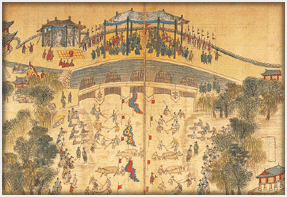|
|


| |
King Yeongjo, the 21st king of the Joseon Dynasty, was the one who put the biggest efforts into the overhauling of the stream in the post-King Sejong period.
It appeared that King Yeongjo was willing to get remembered as a great king taking care of the need for overhauling the stream, like Yu the Great of the Xia Dynasty and King Yangdi of the Sui Dynasty of China, who used to get to be known for their greatest achievements in improving dramatically the management of the river along with their flood control projects.
|
|
For about half a century and until King Yeongjo came to the throne, after the changes made by Kings Taejong and Sejong, the stream saw no drastic change. Its capability remained sufficient to carry out household wastewaters from around 100,000 Seoulites.
|
|
However, the situation changed during the 17th and 18th Centuries. After the Japanese invasion in 1592 and the Manchu War in 1636, the population of Seoul greatly increased with people swarming from every part o the nation: from 80,000 people in 1657 to 190,000 in 1669. Under such circumstances, the amount of wastewaters increased to an extent that could not get covered by
the existing stream.
The situation got even worse since people who had newly moved to Seoul cultivated vegetables on every single space on both sides of the stream, causing some big drainage issues.
They were also using a lot of trees from the mountains as the main source of heat. Earth and sand coming from the bare mountains surrounding Seoul came to fill
up the stream.
|
By 1725, when King Yeongjo came to the throne, the Cheonggyecheon was filled up by the ground and the sand swept from the mountains. The king established
"Juncheonsa (an office in charge of dredging streams)" in October 1759 after analyzing the situation on several
occasions.
The newly established office started with its dredging work in February 1760, dividing the main stream and its tributaries into a total of eight zones and fixing the damaged bridges. The work included overhauling
water channels in all royal palaces.
|

|
The work continued for 57 days, mobilizing a total of 200,000 men per day. In June 1773, retaining walls were made on both sides of the Cheonggyecheon, and curved courses became straight ones, with the work carried out in three different sectors.
|
|
|
|
|
|
|






